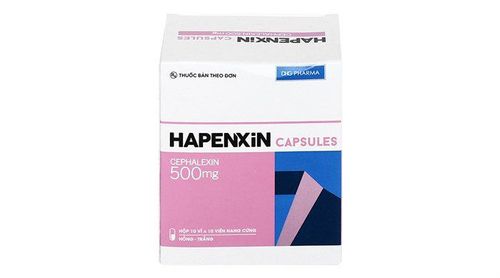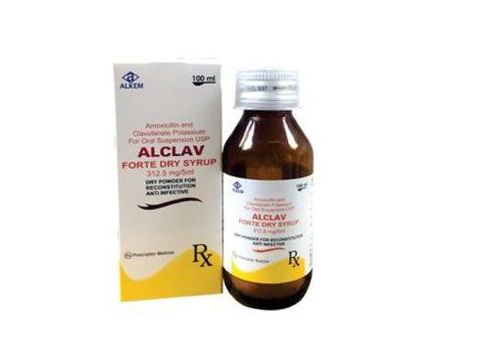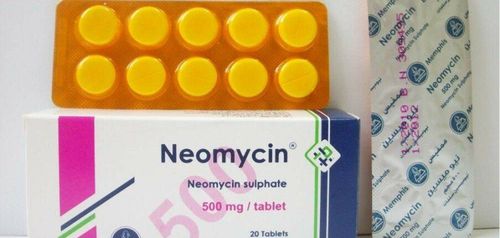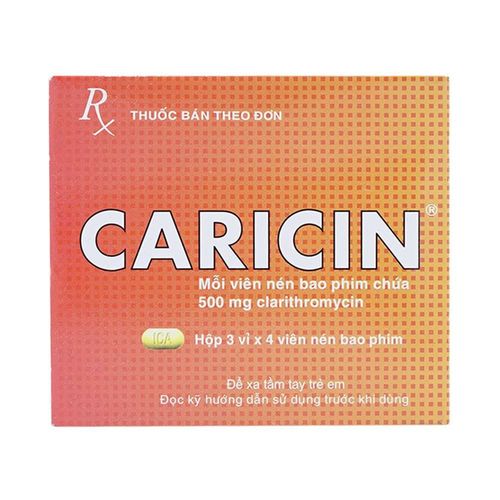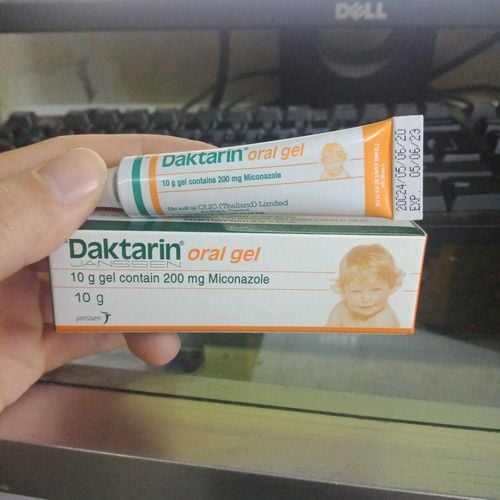This is an automatically translated article.
Cyclindox medicine 100mg contains the main active ingredient Doxycycline and other excipients in a sufficient amount. The drug is used to treat infections caused by susceptible Gram-negative or Gram-positive strains, prevent malaria and diarrhea during travel,...
1. What is Cyclindox 100mg?
Drug group: Cyclindox 100mg belongs to the group of parasites, anti-infectives, antivirals and antifungals. Dosage form: Hard capsule Packing: Box of 10 blisters, each blister contains 10 tablets Ingredients: Doxycycline (as Doxycycline hyclate) 100mg 1.1. Pharmacokinetics of the active ingredient Doxycycline Doxycycline is a broad-spectrum antibiotic that is active against a wide variety of Gram-negative and Gram-positive bacteria. The antibacterial action of the active ingredient Doxycycline is inhibition of protein synthesis.
1.2. Pharmacokinetics of the active ingredient Doxycycline Absorption: The drug Doxycycline is well absorbed from the gastrointestinal tract, about 95% of the oral dose, absorption is reduced when concurrently using dairy products. Distribution: The drug is widely distributed in the body and into tissues and secretions, including urine and prostate. The drug accumulates in the reticuloendothelial cells of the liver, spleen, and bone marrow and in bone, dentin and enamel. Metabolism: Doxycycline is metabolised by the liver. Elimination ability: Doxycycline is mainly excreted in the feces, a small part is excreted in the urine and does not accumulate as much as other tetracyclines in patients with renal failure. 1.3. Effects of the main ingredient Doxycycline Doxycycline is a broad-spectrum antibiotic with bacteriostatic action. Mechanism of action: The active substance causes inhibition of bacterial protein synthesis by binding to the 30S subunit and possibly to the 50S of susceptible bacterial ribosomes, the drug can also cause changes to the plasma membrane. . Spectrum of action: Doxycycline has a wide antibacterial spectrum against gram-positive and gram-negative aerobic and anaerobic bacteria, and also against some microorganisms that are resistant to cell wall drugs, such as Coxiella burnetii, Ureaplasma, Mycoplasma pneumoniae, Rickettsia, Chlamydia spp., Legionella spp., some atypical Mycobacterium, and Plasmodium spp. The drug Doxycycline has no clinical antifungal effect. Doxycycline is also less hepatotoxic than tetracyclines and has an advantage in dosing, because plasma concentrations are similar when oral or injected.
2. What does Cyclindox 100mg do?
Cyclindox medicine 100mg is effective in the treatment of infections caused by many susceptible Gram-positive and Gram-negative strains and some microorganisms, including:
Treatment of skin and soft tissue infections such as acne Treatment of bacterial infections Respiratory tract: chronic bronchitis, sinusitis, pneumonia. Treatment of eye infections: Both treatment of conjunctivitis, in combination with topical drugs or as monotherapy. Treatment of lymphadenitis, inguinal granulomatosis, chancroid. Treatment of Rickettsia: Q fever, rocky mountain spot fever, typhus group infections, endocarditis caused by Coxiella, tick fever. Treatment of urinary tract infections and sexually transmitted diseases: uncomplicated endometriosis, rectal infections, non-gonococcal urethritis caused by Ureaplasma urealyticum. Treatment of malaria caused by chloroquine-resistant Falciparum. Treatment of other infections: Cholera, Brucella disease, M. pseudomallei infection, tick and louse relapsing fever, plague, Parrot and rabbit fever, nasopharyngitis, therapy adjunct to amebic drugs in the treatment of acute intestinal amoeba infections. Prevention of diseases: Malaria and diarrhea in travelers, spirochetes or typhus. Alternative therapy in the treatment of spirochetes, gas gangrene and tetanus.
3. Usage and dosage of Cyclindox 100mg
3.1. How to use the drug You should take Cyclindox 100mg during or after a meal with plenty of water in an upright or sitting position.
3.2. Therapeutic dose of the drug For adults:
Treatment of acute infections, usually use a dose of 2 tablets on the first day, taken once or divided into several times. Then take 1 tablet / time / day with a maintenance effect. For severe infections, 2 tablets/day should be prescribed throughout the course of treatment. In the treatment of Streptococcus infections, Cyclindox 100 mg should be used for at least 10 days to prevent the development of rheumatic fever or glomerulonephritis. Treatment of malaria caused by falciparum resistant to Cloroquin: Take 2 tablets / day, for at least 7 days. Treatment of relapsing fever caused by ticks and lice: Take 1 tablet or 2 tablets depending on the severity of the infection. Conventional acne treatment: Take 50mg/day, with food or juice, for 6 to 12 weeks. Prophylaxis of traveler's diarrhea in adults: Take 2 tablets once on the initial day (or 1 tablet every 12 hours), followed by 1 tablet daily during the stay. Treatment of uncomplicated gonococcal infections, except for anorectal infections in men, uncomplicated endometritis caused by Chlamydia trachomatis, urinary or rectal infections, and non-gonococcal urethritis by Ureaplasma urealyticum: Take 1 tablet/time x 2 times/day x 7 days. Prophylaxis of malaria in adults and children over 12 years of age: Take 1 tablet daily 1 or 2 days before arrival in malaria areas, continue daily during the stay and for 4 weeks after departure. from the malarial area. Prevention of typhus: Take a single dose of 2 tablets. Leptospira prevention: Take 2 tablets once a week while living in epidemic areas and take 2 tablets at the end of the trip. For the elderly and children over 12 years old: No dose adjustment is required.
For children under 12 years: It is not recommended to use the drug.
For people with liver failure: Use with caution in treatment.
For people with renal failure: Use single treatment dose, no need to reduce dose.
4. In case of overdose or forgetting to take a dose of Cyclindox 100mg
In case of missed dose: You need to use it as soon as you remember it as soon as possible. You should skip the missed dose if it is almost time for your next dose, take your next dose as scheduled.
In case of overdose: Currently, there is limited information on overdosage of Cyclindox 100mg, which rarely occurs at acute antibiotic doses. Treatment: Immediately stop using the drug and take the user to the nearest medical facility immediately if symptoms of overdose appear. The doctor may prescribe gastric lavage in combination with appropriate supportive treatment.
6. Undesirable effects of the drug Cyclindox 100mg
Signs of systemic adverse effects: hypotension, dyspnea, hypersensitivity reactions, peripheral edema, angioedema, tachycardia, urticaria, pericarditis, serum sickness,... With the musculoskeletal system: Muscle pain, joint pain. With central and peripheral nervous system: fontanelle in children, headache, benign increased intracranial pressure in adolescents and adults. With autonomic nervous system: Appears signs of hot flushes. With the urinary system: Increased urea in the blood. With auditory/vestibular: Tinnitus appears. With the digestive system: Abdominal pain, diarrhea, vomiting accompanied by anorexia, dyspepsia, rarely dysphagia, esophagitis. In addition, signs of hepatobiliary disease such as jaundice, hepatitis, liver failure and pancreatitis are rare. With dermatology: Appears many skin rashes including maculopapular rash, erythema multiforme, erythema multiforme, exfoliative dermatitis, toxic epidermal necrolysis, photosensitive reaction. With blood: Thrombocytopenia, neutrophils, hemolytic anemia, Porphyrin metabolism disorders, eosinophilia. The use of medicine Cyclindox 100mg can change tooth color and enamel production if used for a long time. If you have any other side effects while using this medicine, please inform your doctor or qualified pharmacist for appropriate assistance.
7. Interactions of Cyclindox 100mg
Caution when using Cyclindox 100mg in combination with the following drugs:
Warfarin: Increases the effect of anticoagulants. Methoxyflurane: May cause death due to nephrotoxicity. Rifampicin: Leads to decreased plasma concentrations of Doxycycline. Calcium, Zinc, Magnesium, Amino Acid, Iron: Decreases absorption of these substances. Anti-typhoid vaccine, oral contraceptives, Penicillin: When used in combination, the ability to make these drugs less effective. Phenytoin, Barbiturates, Carbamazepine: May reduce the half-life of doxycycline in serum. Neuromuscular blocking agents, Vitamin K antagonists, Retinoic acid derivatives: Increases toxicity of these drugs. Iron salt, Bismuth Subsalicylate: Decreased bioavailability of the drug Doxycycline. Antacids containing Magnesium, Aluminum, Calcium, other drugs containing this cation: Reduce the absorption of the drug Doxycycline. Ciclosporin: Leads to increased plasma concentrations of this drug. Co-administration of Doxycycline with an antacid containing aluminum, calcium, or magnesium may reduce the effectiveness of the antibiotic, and iron and Bismuth subsalicylate may reduce the bioavailability of Doxycycline. With Barbiturates, Phenytoin and Carbamazepine can reduce the half-life of the drug Doxycycline.
7. Some notes when using Cyclindox 100mg
7.1. Contraindications of the drug Cyclindox 100mg is contraindicated in the following cases:
Children under 12 years of age. People with severe liver failure. Persons who are sensitive or sensitive to any component of the drug or antibiotics of the other tetracycline group. 7.2. Drug use with pregnant women and nursing mothers For pregnant women: Cyclindox 100mg drug distributed across the placenta. During the second half of pregnancy, the drug can cause enamel damage, structural disorders and accumulation in bones, permanent tooth discoloration. Therefore, do not use Cyclindox 100mg for pregnant women. For lactating women: Cyclindox 100mg is excreted in breast milk. Therefore, do not use the drug for this subject. 7.3. Other Special Notes Cyclindox 100mg is available by prescription and over the counter. Cyclindox 100mg should be used with caution in people with liver failure, taking drugs that are harmful to the liver. Discontinue Cyclindox 100mg if resistant strains develop and institute appropriate alternative therapy. Consider the diagnosis of pseudomembranous colitis in people who are experiencing diarrhea after taking the drug. Caution should be exercised in persons exposed to direct sunlight due to increased sensitivity of the drug to the sun leading to an exaggerated sunburn reaction. Cyclindox 100mg should not be used for people with hereditary problems of galactose intolerance, Lapp lactase deficiency, glucose - galactose malabsorption. Most people who develop signs of inflammation and ulceration of the esophagus take the medicine right before bedtime with insufficient water. Use with caution in people with myasthenia gravis due to the risk of neuromuscular blockade. Cyclindox medicine 100mg contains the main active ingredient Doxycycline and other excipients in a sufficient amount. The drug is used to treat infections caused by susceptible Gram-negative or Gram-positive strains, to prevent malaria and diarrhea during travel, etc. To ensure effective treatment and avoid adverse effects. Unwanted side effects, patients need to strictly follow the instructions of the doctor, professional pharmacist.
Follow Vinmec International General Hospital website to get more health, nutrition and beauty information to protect the health of yourself and your loved ones in your family.
Please dial HOTLINE for more information or register for an appointment HERE. Download MyVinmec app to make appointments faster and to manage your bookings easily.




